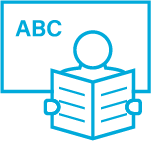


In this study, 202 grade 1 students were divided to three groups: a GraphoGame group, A GraphoMath group, and a control group with teaching as usual. Those playing computer-based games (especially GraphoGame) improved their reading skills to a greater extent than those in the control group.
Author: Pamela J. February
Source: February, P. J. (2018). Teaching and learning to read in Afrikaans: Teacher competence and computer-assisted support. Jyväskylä: University of Jyväskylä, 2018, 138 (JYU Dissertations 5). http://urn.fi/URN:ISBN:978-951-39-7515-9
In this study, the effectiveness of a digital reading tool called GraphoGame Afrikaans that could be used as one of the solutions to poor reading results in Namibia was investigated. Participants were 202 grade 1 students divided to three groups: a GraphoGame group, a GraphoMath group, and a control group with teaching as usual. Those playing computer-based games (especially GraphoGame) improved their skills to a greater extent than those in the control group.
What is phonological awareness?
What is letter knowledge?
What is GraphoGame?
How do children become skilled decoders? Five developmental phases by Ehri 1989:

The study
The aim of this study was to investigate the effectiveness of the GraphoGame Afrikaans game in supporting grade 1 learners’ reading acquisition in a regular classroom.
Research questions:
Participants The study included 202 grade 1 students in Namibia divided into 3 groups: one group played the GraphoGame (n = 82), a control group had class as usual (n = 40), and the third group played the GraphoMath game (n = 80), a computer-assisted mathematics game.

Findings

Implications Playing computer-assisted games increased children’s skills more than regular teaching. This was especially evident when they played GraphoGame. Thus, GraphoGame may be a way to provide individualised teaching to learners in large sized classes in Namibia, helping support teachers in their work and improving the children’s skills.